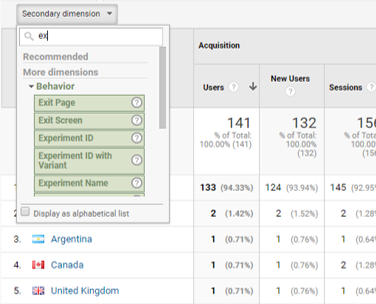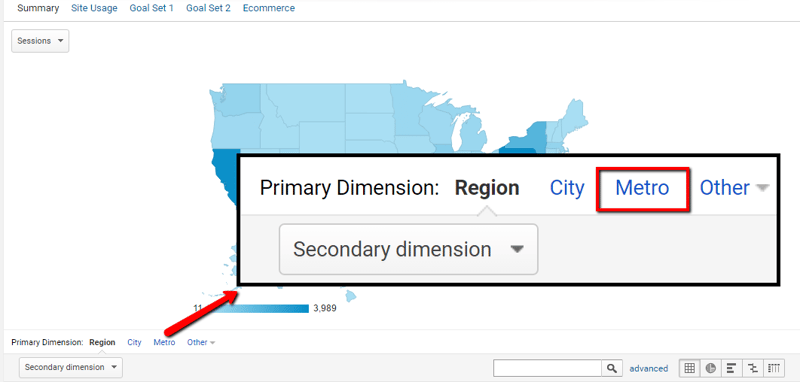Browsing the Midst of Secondary Measurement in Google Analytics: A Thorough Exploration on Its Performance
In the realm of electronic analytics, the details of data analysis often hold the trick to unlocking important understandings. Within the large toolkit of Google Analytics lies an attribute that works as a surprise treasure for those that look for a deeper understanding of customer habits and web site performance. Additional measurements, though apparently simple initially glimpse, harbor a wealth of untapped potential waiting to be harnessed. As we begin on this trip to explore the nuanced capability of second measurements, we will discover how this feature can light up patterns, reveal correlations, and inevitably pave the method for educated decision-making in the electronic landscape.
Comprehending Additional Measurements in Google Analytics

Recognizing exactly how secondary dimensions work is critical for leveraging the complete power of Google Analytics. By combining key metrics with second dimensions, you can get important insights that drive educated decision-making and optimization methods.
Leveraging Second Measurements for Information Analysis
Building upon the foundational understanding of just how second dimensions boost data analysis in Google Analytics, the utilization of these added layers of details becomes paramount in drawing out beneficial understandings for notified decision-making and optimization techniques. By leveraging second dimensions, analysts can dive deeper right into the efficiency metrics by including even more context to the primary measurements, hence uncovering hidden patterns and connections that may not be evident initially look. This deeper degree of analysis allows businesses to much better recognize individual habits, identify trends, and determine areas for improvement.
Furthermore, second measurements supply an even more detailed view of the information, enabling segmentation based upon numerous specifications such as demographics, tools, traffic sources, and extra. This segmentation promotes a much more granular analysis, enabling services to customize their methods and projects to particular target market segments for boosted targeting and personalization. In essence, the tactical usage of additional measurements equips organizations to make data-driven choices that drive development and success in the digital landscape.
Advanced Strategies for Secondary Dimension Execution
Discovering intricate approaches to harness the full potential of second measurements in Google Analytics elevates the deepness and sophistication of information evaluation for tactical decision-making. One sophisticated strategy for applying secondary dimensions is making use of customized measurements. By specifying customized dimensions, users can section data even more to acquire even more particular insights right into customer actions, such as tracking interactions with details elements on a web page or checking the efficiency of a certain advertising and marketing campaign. Another advanced method is the utilization of regex (routine expressions) within secondary measurements. Regex permits for even more effective and versatile pattern matching, allowing users to produce intricate filters for information evaluation. Furthermore, integrating additional measurements with advanced segments can give a lot more granular insights by using numerous layers of segmentation to the data. This method permits for a much deeper understanding of individual actions based on various criteria simultaneously. Executing these sophisticated methods for additional dimensions in Google Analytics empowers customers to carry out a lot more sophisticated analysis and make data-driven decisions with precision.
Interpreting Insights Via Secondary Measurements

When interpreting understandings via second dimensions, it is important to take into consideration the context of the data and exactly how various dimensions interact with each various other. For example, understanding which details traffic resources result in higher conversion rates or recognizing which tools customers favor for making acquisitions can offer actionable understandings for enhancing advertising and marketing projects and improving overall internet site performance. By meticulously checking out the data with additional measurements in mind, services can make enlightened choices that drive significant results and boost their digital existence.
Maximizing Efficiency With Secondary Measurements

One key method to optimize efficiency with additional dimensions is by segmenting information more granularly. This enables you to isolate certain aspects that might be influencing your metrics and gain a far better understanding of what drives success or failure in your digital efforts. As an example, by combining additional dimensions such as 'tool group' and 'touchdown page,' you can identify which tool kinds are most reliable for particular landing pages, enabling you to customize your strategies accordingly.
Moreover, using secondary measurements can aid you recognize patterns, patterns, and relationships that may not appear when assessing data with main measurements alone. This deeper level of evaluation can bring about more enlightened decision-making and ultimately improve the overall performance of your web site or digital advertising campaigns.
Conclusion
In verdict, additional measurements in Google Analytics play a crucial duty in improving information analysis and giving much deeper insights into site efficiency. By using sophisticated techniques and interpreting the data properly, services can optimize their techniques and boost general efficiency. Comprehending the performance of secondary dimensions is necessary for making educated choices and driving success in the digital landscape.
By leveraging secondary measurements, analysts can delve much deeper right into the performance metrics by adding more context to the main measurements, thus uncovering hidden patterns and relationships that may not be obvious at first glimpse. One sophisticated strategy for implementing secondary dimensions is the usage of custom measurements.Having understood innovative strategies like customized measurements and regex imp source for second dimension execution in Google Analytics, the following essential action is analyzing the useful understandings acquired via these advanced data segmentation techniques. Analyzing understandings with secondary measurements involves assessing the connections in between the second and key dimensions picked, discovering patterns, fads, and connections that might not be quickly evident when looking at the data in its entirety.When analyzing understandings with additional measurements, it is crucial find out here to think about the context of the information and exactly how different measurements engage with each other.